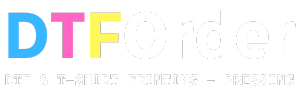DTF (Direct to Film) printing systems have revolutionized the textile printing industry, offering a versatile and efficient solution. Our company extends these services across America, where DTF Transfer is reshaping the landscape of textile printing. Traditional methods such as screen printing or DTG (Direct to Garment) are now complemented by DTF's quicker and simpler process, yielding significant savings in time, resources, and labor.
This innovative system enables printing on a vast array of textile products and fabrics, across any desired area. The process involves transferring prints from PET film, created by a DTF printer, onto the fabric using a heat press. The result is a vibrant print that resists stretching and tearing, ensuring longevity and durability.
Clients can effortlessly place orders through our website, submitting their chosen designs, logos, or photographs. We value detailed specifications, ensuring all nuances and preferences are addressed. Orders are processed promptly, transformed into transfer paper via a temperature-controlled system, and swiftly delivered for client use. This service allows for the application of prints to various clothing items and textiles at one's convenience.
Applications of the DTF Machine:
The DTF transfer printing system is versatile and high-quality, suitable for both small and large-scale textile applications. Its digital nature allows for widespread use, from individual projects to mass production in factories. Here's where our DTF printing system can be effectively utilized:
- T-shirt and apparel printing
- Workwear
- Raw fabric processing
- Accessory printing (bags, hats, masks)
- Form printing and more
Requirements for DTF Printing:
To achieve the best results with a DTF printer, the following components are essential:
- DTF Printer: The core of the process, specialized for DTF printing.
- PET Film: The medium onto which the print is initially transferred.
- Powder (Glue): Used to adhere the print to the textile.
- Heat Press: Ensures the transfer of the print from the PET film to the fabric.
- Textile Product: The final substrate for the print.
The process begins with the preparation of the digital image, followed by processing in a RIP machine for print readiness. The DTF printer then transfers the print onto PET film. After a confectionery and drying process, the print is applied to the desired textile using the heat press.
Features of DTF Textile Printing:
Our DTF pigment inks are tailor-made for compatibility with DTF printers, ensuring exceptional print results on textiles. The versatility of this printing technique allows for application on a wide range of materials, including cotton, leather, wood, swimwear, and high-elastic fabrics.
Key features of DTF textile printing include:
- High color intensity with excellent saturation.
- Resistance to washing and long-term durability.
- Eco-friendly and non-toxic ink composition.
- Vibrant, fade-resistant colors suitable for various applications.
DTF printing stands out for its ability to maintain high-quality prints even under regular washing conditions, including temperatures of 30 degrees and above. This technology not only meets but exceeds the dynamic needs of modern textile printing, offering a reliable, versatile, and high-quality solution for a wide array of printing needs.

